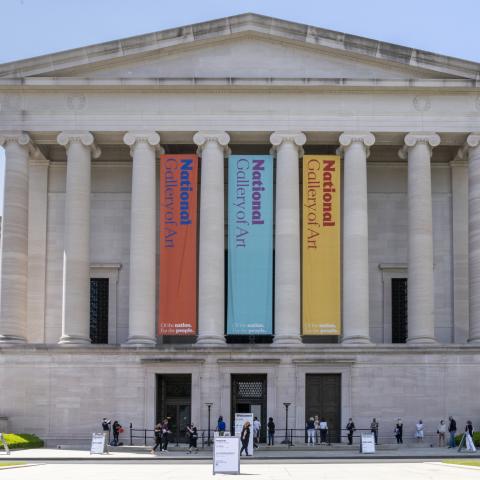Christ among the Doctors
c. 1495/1497
Artist, Spanish, active c. 1485/1500


West Building Main Floor, Gallery 38
Artwork overview
-
Medium
oil on panel
-
Credit Line
-
Dimensions
overall (original painted surface): 136.2 x 93 cm (53 5/8 x 36 5/8 in.)
overall (with addition at bottom): 155.2 x 93 cm (61 1/8 x 36 5/8 in.)
framed: 183.5 x 128.9 x 12.1 cm (72 1/4 x 50 3/4 x 4 3/4 in.) -
Accession
1952.5.43
Artwork history & notes
Provenance
Possibly commissioned for a convent or church in Valladolid, Spain.[1] Before 1919, José María de Palacio, Conde de las Almenas, Madrid;[2] sold 28 March 1919 to (Frank Partridge and Sons, Ltd., London).[3] Dr. Preston Pope Satterwhite [1867-1948], New York, by 1933;[4] possibly purchased by (French & Co., New York).[5] purchased 1941 by the Samuel H. Kress Foundation, New York;[6] gift 1952 to NGA.
[1] The probable patronage of the Catholic Kings has led Van der Put and subsequent commentators to posit that the altarpiece was commissioned for a church or convent in Valladolid. Albert van der Put, typescript, c. 1922, in NGA curatorial files. The painting has qualities characteristic of Spanish paintings in northern Castile during the reign of the Catholic Kings. Among cities in the region, Valladolid was the one most favored by the monarchs, who occasionally held court there. The theory that the panels were intended for an institution in Valladolid is plausible, but cannot be regarded as certain. Even if the paintings were created in northern Castile, they could have been commissioned for an institution in another part of Spain.
[2] This painting is shown hanging on a wall of the Madrid residence of the Conde de las Almenas in a photograph in Arthur Byne and Mildred Shapley, Spanish Interiors and Furniture, 2 vols. (New York, 1922), 2: pl. 109.
[3] Frank Partridge, memorandum, 1924, in the files of the Frick Art Reference Library, New York.
[4] Chandler R. Post, A History of Spanish Painting (Cambridge, Mass., 1933), v. IV, pt. II, 418.
[5] From Colin Eisler, Paintings from the Samuel H. Kress Collection: European Schools Excluding Italian (Oxford, 1977), 178 and provenance card, NGA curatorial files; however in her 26 August 1988 letter, Martha Hepworth of the Getty Provenance Index indicates that these panels do not appear in the French & Co. stock books, which are now at the Getty. Robert Samuels, Jr., a representative of French & Co., searched the French & Co. records still kept at the New York office, but also was unable to find any references to the two panels.
[6] Provenance card, NGA curatorial files. See also The Kress Collection Digital Archive, https://kress.nga.gov/Detail/objects/501.
Associated Names
Exhibition History
1935
Exhibition of Spanish Painting, The Brooklyn Museum, 1937, no. 7.
1937
Spanish Paintings, Philadelphia Museum of Art, 1937, no cat.
1951
Paintings and Sculpture from the Samuel H. Kress Collection, National Gallery of Art, Washington, 1951, 178, no. 78.
Bibliography
1913
Mayer, August L. Geschichte der spanischen Malerei. Leipzig, 1922: 145 (also Spanish ed. Madrid, 1942: 166).
1933
Post, Chandler Rathfon. A History of Spanish Painting. 14 vols. Cambridge, Mass., 1930-1966: 4, pt. 2:418-428.
1937
Clifford, Henry. "Great Spanish Painters: A Timely Show." Art News 35 (17 April, 1937): 9.
1952
Brans, J. V. L. Isabel la católica y el arte hispanoflamenco. Madrid, 1952: 130-132.
1958
Gaya Nuño, Juan Anotonio. La pintura española fuera de España; historia y catàlogo. Madrid, 1958: 274, no. 2274.
1959
Paintings and Sculpture from the Samuel H. Kress Collection. National Gallery of Art, Washington, 1959: 262, repro.
1965
Summary Catalogue of European Paintings and Sculpture. National Gallery of Art, Washington, 1965: 86.
1966
Gudiol y Ricart, José. "El Pintor Diego de la Cruz." Goya. 70 (1966): 208-217.
1968
National Gallery of Art. European Paintings and Sculpture, Illustrations. Washington, 1968: 75, repro.
Cuttler, Charles D. Northern Painting from Pucelle to Brueghel. New York, 1968: 254.
1975
European Paintings: An Illustrated Summary Catalogue. National Gallery of Art, Washington, 1975: 224, repro.
1977
Eisler, Colin. Paintings from the Samuel H. Kress Collection: European Schools Excluding Italian. Oxford, 1977: 177-178, 181, fig. 182.
1982
Abrams, Richard I. and Warner A. Hutchinson. An Illustrated Life of Jesus, From the National Gallery of Art Collection. Nashville, 1982: 42-43. color repro.
1984
Walker, John. National Gallery of Art, Washington. Rev. ed. New York, 1984: 142, no. 143, color repro.
1985
European Paintings: An Illustrated Catalogue. National Gallery of Art, Washington, 1985: 256, repro.
1988
Wheeler, Marion, ed. His Face--Images of Christ in Art, New York, 1988: 126, no. 26, color repro.
1990
Brown, Jonathan, and Richard G. Mann. Spanish Paintings of the Fifteenth through Nineteenth Centuries. The Collections of the National Gallery of Art Systematic Catalogue. Washington, D.C., 1990: 101-104, color repro. 103.
2004
Hand, John Oliver. National Gallery of Art: Master Paintings from the Collection. Washington and New York, 2004: 70-71, no. 52, color repro.
Inscriptions
on Mary's mantle (in relief, deciphered with infrared reflectography): ENIHSO IOEEPRS IMO[?]SSIEE OE OEI
Wikidata ID
Q20174640


